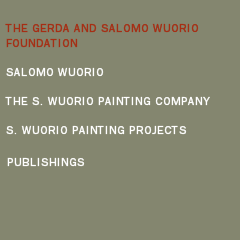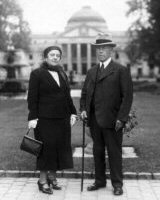THE GERDA AND SALOMO WUORIO FOUNDATION
The purpose of the foundation
The purpose of the foundation is to promote visual arts, applied arts, architecture and educational work in the professional field of painters. In order to fulfil its purpose, the foundation gives out grants annually on the 28th of August, to the organisations listed below, from the gross revenue of its estate. The foundation may also promote the realisation of its purpose to a lesser degree by means of other activities.
The Gerda and Salomo Wuorio Foundation board of trustees 2022–2025
Hannu Hokka (chair), Finnish Academy of Fine Arts and Finnish Art Association
Satu-Minna Suorajärvi (vice-chairperson), Artists' Association of Finland
Salla Heinänen, Ornamo Art and Design Finland
Paula Huotelin, Finnish Association of Architects
Matti Nurminen, Association of Finnish Sculptors
Heidi Tirkkonen Design Forum Finland
Annukka Wiikinkoski, Helsinki School of Special Painting
The annual shares
In 2025 the annual shares of the beneficiary organizations were 700,000 euros altogether.
In 2024 the annual shares of the beneficiary organizations were 665,000 euros altogether.
In 2023 the annual shares of the beneficiary organizations were 700,000 euros altogether.
In 2022 the annual shares of the beneficiary organizations were 910,000 euros altogether.
In 2021 the annual shares of the beneficiary organizations were 770,000 euros altogether.
In 2020 the annual shares of the beneficiary organizations were 840,000 euros altogether.
In 2019 the annual shares of the beneficiary organizations were 665,000 euros altogether.
In 2018 the annual shares of the beneficiary organizations were 700,000 euros altogether.
In 2017 the annual shares of the beneficiary organizations were 700,000 euros altogether.
In 2016 the annual shares of the beneficiary organizations were 525,000 euros altogether.
In 2015 the annual shares of the beneficiary organizations were 840,000 euros altogether.
In 2014 the annual shares of the beneficiary organizations were 350,000 euros altogether.
In 2013 the annual shares of the beneficiary organizations were 336,000 euros altogether.
In 2012 the annual shares of the beneficiary organizations were 294,000 euros altogether.
In 2011 the annual shares of the beneficiary organizations were 315,000 euros altogether.
In 2010 the annual shares of the beneficiary organizations were 266,000 euros altogether.
In 2009 the annual shares of the beneficiary organizations were 224,000 euros altogether.
In 2008 the annual shares of the beneficiary organizations were 266,000 euros altogether.
In 2007 the annual shares of the beneficiary organizations were 546,000 euros altogether. In 2007, the foundation gave each organization an additional share of 40,000 euros to mark the jubilee year.
History of the foundation
The sole heir of Salomo and Gerda Wuorio, architect Karl Gunnar Valdemar Wuorio, died unmarried on July 18, 1965. Gunnar Wuorio's will had clear instructions for the administrators of the estate. After taking care of all the necessary expenses, they were to make four donations according to the wishes of Gerda and Salomo Wuorio. Two million (old) Finnish marks was to be donated to the city of Helsinki for the purchase of monumental paintings for public buildings. The pension institutions for the employees of the S. Wuorio wallpaper and carpet department and S. Wuorio painting department were both granted two million marks. One million marks was to be donated to the Mannerheim League for Child Welfare and the same amount was allotted to the parish of Salomo Wuorio's birthplace, Hausjärvi, to be used for the benefit of the pupils at the village school. The will also had instructions for the distribution of the most valuable chattels. The Kalevala themed paintings by Pekka Halonen and Väinö Blomstedt were to be given to the Kalevala Society. Other works of art were to be donated to the Ateneum Art Museum.
The establishment of the foundation
After the donations had been made in accordance with the will, a foundation that carried the names of his mother and father was to be established. The board of trustees was to be formed so that each of the following organisations were to nominate one member in it: the Finnish Academy of Fine Arts and Finnish Art Association together, the Artists' Association of Finland, the Association of Finnish Sculptors, the Finnish Society of Crafts and Design, the Finnish Association of Designers Ornamo, the Finnish Association of Architects and the Helsinki School of Special Painting. The net income of the foundation was to be divided equally to the above-mentioned organisations.
The trust fund included two properties. Unioninkatu 30 was located in the business centre between Aleksanterinkatu and Pohjoisesplanadi. The Wuorio & Co. carpet and wallpaper shop operated on the two lowest floors and the four uppermost floors comprised offices and flats. The six-storey building at Unioninkatu 10 was located on the edge of the business centre. The ground floor was occupied by the S. Wuorio painting workshop. Other real property consisted of fifteen flats. In addition, the trust fund included among other things gold, jewellery, bank deposits and a plot of land in Spain.
The executors of the will, Master of Laws Bo Bäckström and engineer Elo Durchman, framed the constitution of the foundation in accordance with the basic directions set out in the will. The constitutive meeting of the Gerda and Salomo Wuorio Foundation was held on March 11, 1966. The members of the first board of trustees were Master of Laws Viljo Hakulinen (Finnish Academy of Fine Arts and Finnish Art Association), Bachelor of Economic Sciences Pauli Paaermaa (Artists' Association of Finland), Johan Finne (Association of Finnish Sculptors), managing director Olof Gummerus (Finnish Society of Crafts and Design), architect Markku Visanti (Finnish Association of Designers Ornamo), architect Pertti Luostarinen (Finnish Association of Architects) and principal Osmo A. Voutilainen (Helsinki School of Special Painting). In its first whole year of operation, 1967, the foundation distributed 20,000 Finnish marks to each of its beneficiary organizations on Salomo Wuorio's birthday, the 28 th of August. In the same year, a committee was set up to plan the investment of the foundation's funds.
Unfortunate investments
The widespread migration from the countryside to the cities after the wars created a housing shortage, and the state began to encourage the construction of housing with state-subsidized housing loans. As the Wuorio foundation was planning the investment of its funds, the construction of housing rose to the fore. In June 1968, Helsingin Haka was chosen as a partner. The construction zone for state-subsidized housing blocks was in Länsimäki, which was a part of the rural district of Helsinki (the present-day Vantaa). The last building of the massive projects was finished in late summer 1971. The construction project had lasted for over three years and its outcome were eleven housing blocks with 494 flats and six studios to be leased out to artists.
Hvitträsk is mentioned for the first time in the minutes of the Gerda and Salomo Wuorio Foundation in December 1968. There chairman Luostarinen gives an account of the negotiations to purchase Hvitträsk for the foundation with financing from the KOP bank. The residence and studio building designed for themselves by the architect trio Gesellius – Lindgren – Saarinen had passed to the KOP bank in a forced sale. The decision to purchase Hvitträsk was made by the board of trustees in August 1969. The opening of Hvitträsk was celebrated on June 8, 1971. In addition to an exhibition organised by the Museum of Finnish Architecture comprising Eliel Saarinen's original drawings, exhibitions by the Association of Finnish Sculptors and the Guild of Medallic Art in Finland were organised in Hvitträsk during the first summer.
Both the construction of Länsimäki and the purchasing, restoration and maintenance of Hvitträsk soon proved to be financially unsustainable projects. It was necessary to take action to reduce the amount of loans. The decision to sell Unioninkatu 10 was made in September 1972, and seven years later the board also had to give up the property at Unioninkatu 30, a.k.a. the Wuorio business palace. Following lengthy negotiations, the Länsimäki buildings were finally sold to the city of Vantaa in March 1978. The state took control of the Hvitträsk property in early 1981.
Operations stabilize
During 1976–80, the shares for the beneficiary organizations were not distributed, but after the turn of the decade the foundation's economic situation began to stabilize, and the beneficiary organizations again received their annual shares. Over the 1980's, the shares grew substantially. During the time between 1983 and 1990 the share received by the beneficiary organizations tripled. For the past few years, the foundation's funds have been invested in stocks. Successful investments and the revival of economic life have made it possible to increase the shares even more. By distributing annual statutory shares, the foundation continues the life work of Salomo Wuorio.

